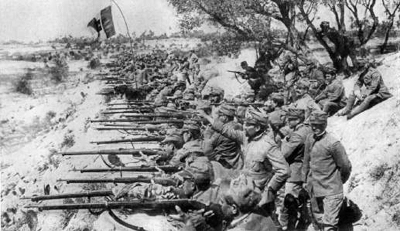The Germans beat a consignment of Portuguese and re-took Passchendaele.
The war had suddenly become a war of movement again and both sides found it difficult to overcome the logistical difficulties of maintaining supplies. Now, the Americans had finally landed – initially with 180,000 troops, led by their commander, General John ‘Black Jack’ Pershing.

Hindenburg, Wilhelm II and Ludendorff, March 1918
Ludendorff decided the momentum had to be maintained. On 27 May, he struck at the southern end of the Western Front, over the River Aisne. By 30 May, the Germans had reached the River Marne and were now just forty miles from Paris. But again the Germans were checked, most notably in the Battle of Belleau Wood, where they were beaten back by a unit of US marines. At one point, their French, advising the US commander to retreat, received the reply, ‘Retreat? Hell, we just got here.’
In the midst of war, troops on all sides were being decimated by a global pandemic of what became known as Spanish flu. Perhaps the biggest pandemic in history, it affected a fifth of the world’s population and killed 50 to 100 million people. Soldiers were particularly susceptible, given their levels of fatigue and stress, their lack of cleanliness and unhealthy living conditions.
The Hundred Days
Exhausted and demoralized, the last German offensive had come to an end. Now, instead, they faced the Allies’ ‘Hundred Days’ counter offensive. Starting on 18 July, the Allies pushed the Germans back beyond the River Marne. German dreams of reaching Paris were dead. The Battle of Amiens on 8 August saw the Germans lose 30,000 men, in what Ludendorff described in his post-war diaries as a ‘black day for the German army’. By the beginning of September the Germans were back on their Hindenburg Line, from where they had started their Spring Offensive almost six months previously. German soldiers were deserting or being taken prisoner of war at alarming rates. Huge numbers succumbed to the Spanish Flu.
On 29 September, Bulgaria became the first of Germany’s allies to surrender, its king, Ferdinand I, abdicating. Domestically, revolution in Germany was looming. Ludendorff wanted to accept Wilson’s Fourteen Points and its promise of non-punitive measures, a plan which the British and the French found far too lenient. Ludendorff urged also, in order to strengthen the German cause, the introduction of a ‘government [with] a broader foundation’. It was a devious move on Ludendorff’s behalf – pass the responsibility for a German surrender to a parliamentary government and then let them, not the military, take the blame for the nation’s defeat.
On 3 October the Kaiser duly appointed the liberal Prince Maximilian of Baden Chancellor of Germany. But it was not enough for Wilson – he demanded the Kaiser’s abdication. This was too much for Ludendorff who, having previously said the war was lost, was now keen to maintain hostilities. On 26 October he was dismissed.
Elsewhere Germany’s allies were falling. The year before, in October 1917, a joint German and Austrian–Hungarian offensive won the Battle of Caporetto against the Italians. A devastating blow for the Italians, they were pushed back to the River Piave, only fifteen miles from Venice.

Italian troops on the Isonzo river, c. 1918
In June 1918, the Austrian–Hungarians had tried but failed to destroy the Italians. The Italians waited four months before counter-attacking, by which time Germany was no longer in position to offer its ally reinforcements. During the course of the Battle of Vittorio Veneto, the Austrian–Hungarian empire as a political entity collapsed. On 28 October, Czechoslovakia declared its independence from the empire. The following day, the South Slavs did likewise, and was soon to become Yugoslavia. Hungary followed suite on 31 October.
1 comment